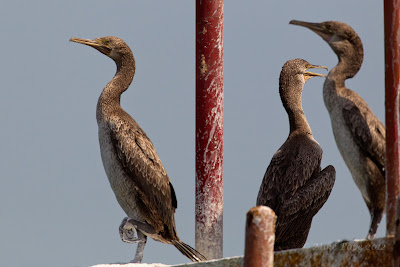Week 41, 11 October 2012 - Al Abraq (Click to enlarge image)
I needed to get out and enjoy some autumn birding and Al Abraq with it's diversity of habitat is special place, despite the usual shooters on the boundary with their Oriole playbacks spoiling the tranquility.
I was able to leave early to miss the bulk of the traffic on the 6th Ring Road and was through the farm gates just after 6am. Two juvenile Black-crowned Night Herons were seen at the pond just inside the gate, one of them swimming around in the water like a duck.
 |
| Black-crowned Night Heron (Nycticorax nycticorax) |
A little later I was joined by Khaled Al Ghanim and we searched for the Levants Sparrohawk(s) that were found earlier in the week by Pekka, without success. There were however numerous Accipiters around the farm and all those that we did get good sightings of were European Sparrowhawks.
 |
| Eurasian Sparrowhawk (Accipiter nisus) |
Walking through one of the groves of trees with the naked 600mm, I eventually managed to get an image of one of the two Red-breasted Flycatchers - in these circumstances, hand-held is the only option as these great little birds are very active and don't stay still for long.
 |
| Red-breasted Flycatcher (Ficedula parva) |
Common Chiffchaff's have now arrived as the last of the Willow Warblers are departing
 |
| Common Chiffchaff (Phylloscopus collybita) |
As have White Wagtails which will replace the last of the Yellow Wagtails in the coming weeks
 |
| White Wagtail (Motacilla alba) |
Other raptors seen were Pallid Harrier
 |
| Pallid Harrier (Circus macrourus) |
Common Kestrel, including this one that had escaped along with the raptor trap designed to catch it. So it is will die a slow death if it lands and the loops get caught in branches
 |
| Common Kestrel (Falco tinnunculus) |
A flock of European Bee-eaters were hawking around the pool at the entrance, this one in a fighter jet pose
 |
| European Bee-eater (Merops apiaster) |
Later whilst perched in the tree's, a juvenile Eurasian Golden Oriole joined them and later came down for a drink
 |
| European Bee-eaters (Merops apiaster) and Eurasian Golden Oriole (Oriolus oriolus) |
A last drive around the farm later in the morning produced a juvenile European Honey Buzzard
 |
| Juvenile European Honey Buzzard (Pernis apivorus) |
And my first Spanish Sparrow for this Autumn.
 |
| Male Spanish Sparrow (Passer hispaniolensis) |
And a juvenile Ortolan Bunting that created some initial excitement as I hadnt seen a juvenile before
 |
| Juvenile Ortolan Bunting (Emberiza hortulana) |
By now the wind had picked up together with dust, so I called it a morning and headed back home

































































